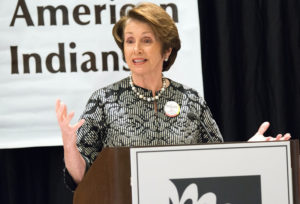
With media attention squarely focused on the foul mouthed and naive Democratic-Socialists elected in 2018, it is easy to forget that the contingent of Democrats who won Nancy Pelosi back her Speakership were from red and purple districts.
These more conservative “Blue Dog” Democrats, now make up a decent sized bloc in the new majority. Without their support, Pelosi will have a hard time passing legislation. Without her support, the Blue Dogs will have a hard time winning reelection.
Will Pelosi bow to the media feeding frenzy over the far-left progressives, or work with the moderates in order to maintain her majority? That’s the theme explored by Josh Rogin in The Washington Post. He writes (abridged):
The Blue Dog Coalition began in 1995 after Democrats lost power in the most stunning electoral defeat of that era.
Originally made up of mostly older, white, Southern men, their name was inspired by the iconic yellow-eyed blue dog painted by artist George Rodrigue. A post- Reconstruction adage had stated that Southerners would rather vote for a yellow dog than a Republican. But by the 1990s, Southern Democrats said that yellow dog was being “choked blue” by the extreme sides of both parties, hence the name Blue Dogs.
The forming principle of the group was that fiscally conservative, national-security-minded Democrats needed to stick together — and occasionally stick it to their own party’s leadership — to survive and get stuff done. But the Blue Dog Coalition will look a lot different in 2019 than it did in 1995:
It now includes Northerners, young people and veterans. It is led by an Asian American woman who served in the Pentagon and just won her first reelection in a purple Florida district that supports both gun control and gay rights.
“We have a unique opportunity,” she said. “It is a moment when the Blue Dogs have an opportunity to be a strong, reasonable voice. . . . In contrast to some of the reckless policies we are seeing.”
They know the progressive far-left Democrats entering Congress are getting the lion’s share of media attention. For example, Rep.-elect Alexandria Ocasio-Cortez (N.Y.) has a district just miles from Rose’s but gets drastically more coverage, in part because of her willingness to oppose party leadership and advocate economic and foreign policy ideas that are outside the mainstream.
The question for likely speaker Nancy Pelosi (Calif.) will be how she balances the wants of the progressive side of her caucus with the needs of the members from red and purple districts who actually gave Democrats the majority.
Sixty-four percent of the 42 seats Democrats flipped in the 2018 midterms will be held by members of the Blue Dogs or the moderate New Democratic Coalition; only 27 percent of those seats will be held by members of the Progressive Caucus. Of the 20 congressional districts now held by Democrats but that favored Trump in 2016, 11 are Blue Dog or New Dem members; only three are in the Progressive Caucus.
Ocasio-Cortez won with 78 percent of the vote. Rose won with less than 53 percent. If Pelosi still wants to be speaker after two years, Democrats must convince constituents in districts such as Rose’s that their party represents them.
The Blue Dogs’ challenge is not just about marketing. They are preaching moderation, compromise and bipartisanship.
Democrats must decide whether they want to assuage their angriest elements or govern from the middle and keep their power.
Read more here.
If you’re willing to fight for Main Street America, click here to sign up for my free weekly email.




